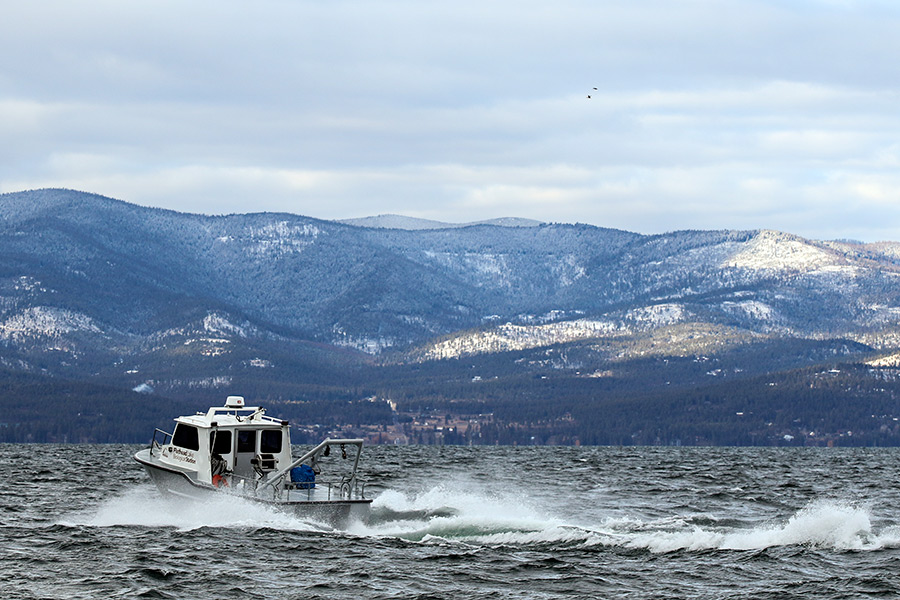Guardians of the Lake
As the Flathead Lake Biological Station delivers its ‘State of the Lake,’ a new leader takes the helm of a group that for 60 years has defended local waters
By Tristan Scott
It’s not by accident that Flathead Lake remains clean, blue, clear, and mussel-free despite the persistent threat of aquatic invaders, development and a warming climate.
Indeed, its defiance of these pressures looming on the horizon is due in large part to the groups and individuals furnishing it with safeguards while monitoring and promoting its health.
Over on Yellow Bay, for example, the Flathead Lake Biological Station recently held its annual open house and delivered a “State of the Lake” report, an annual assessment of the largest freshwater lake west of the Mississippi, whose pristine environment represents an ideal setting for groundbreaking research and a test bed for innovative science.
As the oldest biological field station in the western hemisphere, the Flathead institution has served as the “Sentinel of the Lake” since 1899, tracking water quality, influencing sweeping change in local environmental practices and gathering a groundswell of data.
In 1977, it instituted a scientifically rigorous monitoring program that served as the first line of defense against current and future threats to the health and quality of the Flathead watershed. These threats range from aquatic invasive species — like zebra and quagga mussels, first detected in the Missouri River Basin of Montana in 2016 — to nutrient and biological pollution from degraded shoreline septic systems.
Research conducted at FLBS has been an informative force behind significant water-quality conservation achievements, including the ban of phosphorus-containing detergents and the prevention of mining in the upper North Fork Flathead River. The long history of research and monitoring also has resulted in a glut of scientific discovery and insight, cultivating one of the most robust ecological and water-quality records in the world.
Flathead Lake continues to defy national trends as a healthy blue body of water. In fact, a near record water clarity measurement was just taken by FLBS assistant research professor Shawn Devlin and his Lake Ecology class in mid-August, and all data indicates that Flathead Lake has remained clear and blue for another year. These are positive signs that nutrient pollution remains in check.
“The reason this is so important is because a lot of lakes are not,” Jim Elser, director of the biological station, told members of the public, describing a suite of pioneering research projects his faculty of experts are employing to maintain the pristine quality of Flathead Lake. “I hope I’ll be able to say that for the rest of my career here.”
Elser, a renowned freshwater ecologist, replaced Jack Stanford as director in 2016, moving north from the desert landscape of Arizona, where he was a distinguished scientist, scholar and regent’s professor at Arizona State University. He is the station’s seventh director in its 119-year history.
But threats to the Flathead watershed are always looming on the horizon, Elser said, which is why FLBS has bolstered its monitoring program this year.
Elser also discussed the rarefied event last winter when 90 percent of Flathead Lake froze, an event that has not happened in 30 years and made headlines statewide. Historically, the entire lake froze at least once every 10 years, Elser said.
Another newsworthy event that occurred during the winter was the damage the ice caused to the FLBS’ research and monitoring buoy, destroying the high-tech instruments. Elser encouraged anyone with a stake in the lake to contribute financially to the Bio Station’s mission.
Meanwhile, down at the southern end of Flathead Lake, a nonprofit organization has been standing guard over the lake and ensuring its health for more than six decades, chalking up success stories while providing leadership and a strong voice for protecting and improving water quality through advocacy, education and stewardship programs.
The Flathead Lakers play a key role in protecting the waters of Flathead Lake and its watershed by identifying and successfully advocating for the maintenance of clean water, healthy ecosystems, and a lasting quality of life at the Lake and in the watershed. Over the years, the Lakers have steadily strengthened stewardship, education and membership programs thanks to former Executive Director Robin Steinkraus’ leadership, committed staff, volunteer board, and over 1,500 supporting members.
Following her retirement this summer, Steinkraus and the organization’s board began considering the importance of succession after her long tenure. After a lengthy search, the Flathead Lakers have hired Kate Sheridan as the new executive director, who is pledging to build on a strong record of achievement and a sound financial base.
Sheridan came to Montana to attend the University of Montana’s Environmental Studies graduate program has spent the six years since obtaining her Masters degree working around the state in political, labor, and community organizing. She worked on the Montana Wilderness Association’s public lands campaign and most recently for Lake County Community Development. Originally from the West Coast, Sheridan was drawn to Polson and Flathead Lake as an avid open water swimmer. She assumed the new role on Aug. 1.
“I’m excited to be working for the Lakers, and to be living along Flathead Lake,” she said.